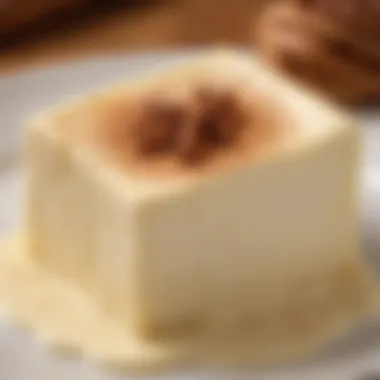Exploring Pay de Queso Mexicano: A Culinary Delight


Intro
In the vibrant tapestry of Mexican cuisine, few desserts evoke as much nostalgia and delight as pay de queso. This traditional cheese pie, often served at family gatherings and festive occasions, embodies a fusion of flavor and history. Originating from a time when Mexican households celebrated the simple joy of homemade treats, pay de queso combines rich textures with a delicate sweetness that elevates it from a mere dessert to a cultural symbol.
As we embark on this culinary exploration, it becomes clear that pay de queso is more than just an indulgent dish. It tells tales of family recipes passed down through generations, each unique yet familiar. This article aims to unravel the essence of pay de queso, shedding light on its origins, variations, and the essential components that make it a staple in Mexican households.
By diving into the details, we will provide not only a comprehensive recipe but also insights into its cultural significance. Whether you are an accomplished chef looking to broaden your repertoire or a novice eager to try your hand at creating something special, pay de queso offers a delightful challenge. So, let’s begin our journey into the heart of this beloved treat.
Prologue to Pay de Queso
When it comes to Mexican desserts, few are as adored as pay de queso. This delightful cheese pie captures hearts and palates alike, acting as a sweet ambassador of Mexican culinary traditions. Not only is it a staple at family gatherings and celebrations, but it also embodies a rich cultural narrative that each bite seems to tell. In this section, we'll delve into the dessert's essence, peeling back layers to examine what makes pay de queso a beloved treat, while also giving a nod to its history and significance.
Understanding the Dessert
At its core, pay de queso is a beautiful amalgam of textures and flavors. Imagine a crisp crust cradling a velvety smooth cheese filling. Made primarily from soft cheese, like queso crema or ricotta, the filling offers a creamy richness balanced by hints of sweetness. And let’s not forget about the crust, which may be rich and buttery or light and flaky, depending on the recipe. This duality makes every bite an adventure; one can almost savor the contrasting sensations as the creamy cheese dances on the palate while the crust adds a delightful crunch.
Despite its simple ingredients, preparations can vary greatly. Some might add vanilla or a hint of lime to the filling, creating a bright note that elevates the entire dish. Others may include unique spices, a sprinkle of cinnamon or nutmeg, reminiscing the flavors often found in traditional Mexican custards. It’s a dessert that not only tantalizes the tongue but also invites exploration.
Cultural Significance
In Mexico, pay de queso holds more than just a place on the dessert table; it’s entwined with familial bonds and communal celebrations. Bringing a pay de queso to a gathering is akin to presenting a cherished gift. It symbolizes warmth and togetherness, often prepared during birthdays, holidays, and significant life events.
Beyond personal connections, this dessert carries a historical narrative intertwined with regional customs. In various states, one can find slight variations: a richer cheese blend in Oaxaca or a more delicate crust in the Yucatán Peninsula. Each region flaunts its own twist, reinforcing that food is not merely sustenance but also a culture’s storytelling medium.
"The heart of a culture often beats strongest in its cuisine."
Thus, the essence of pay de queso extends beyond its flavor. It encapsulates stories of migration, adaptation, and familial legacy. As one indulges in a slice, it’s more than just satisfying a sweet tooth; it’s a sweet voyage through the landscape of Mexican heritage.
Historical Background
The historical background of pay de queso offers a glimpse into much more than mere culinary tradition; it serves as a testament to the mixed cultures that have shaped Mexico's gastronomic landscape. Not merely a delightful dessert, this pie encapsulates stories, identities, and local practices that pass down through generations. Understanding its past allows food lovers to appreciate the myriad influences and ingredients that have contributed to the craft of making this beloved sweet treat.
Origins in Mexican Cuisine
Inspired by the indigenous peoples and Spanish colonizers, the origins of pay de queso gear up a fascinating tale. Ingredients like cheese were anciently manufactured by local tribes, while Spanish settlers introduced various dairy farming techniques. This pie has grown roots deep into the heart of Mexican cuisine, representing an intersection of history, agriculture, and family traditions.
The blend of fresh cheese, often derived from local sources, and a sweetened crust reflects the agricultural abundance found across Mexican regions. Moreover, different areas have showcased their unique take, influenced by availability of ingredients and cooking methods. The diversity in flavors speaks volumes to the regional pride among various Mexican states.
Evolution Over Time
As taste buds evolved and new ingredients entered the Mexican cooking arena, pay de queso transformed, adapting to the changing preferences of its lovers. In the 20th century, a notable shift occurred. The pie began embracing modernity, incorporating flavors and styles borrowed from international cuisine, yet still maintaining its quintessential character.
Today, one can find countless variations, from using Ricotta cheese to adding flavors like lime or chocolate. Each adaptation extends the pie's reach, allowing it to take center stage in modern-day celebrations and gatherings. This evolution is not merely about flavor; it uniquely reflects societal changes and culinary innovation in Mexico.
"Food is a vast cultural narrative, weaving tastes and histories, and pay de queso is a narrative itself, telling tales of its past through every bite."


As more people take an interest in traditional recipes and culinary arts, there's a resurgence of a desire to reconnect with these foundational dishes, leaving an indelible mark on how pay de queso is viewed today. In understanding its history, we not only cherish the pie but celebrate the rich tapestry of Mexican heritage it represents.
Key Ingredients
When discussing pay de queso, the conversation cannot shift far from its key ingredients. The flavors and textures of this dessert hinge on the ingredients used, making each element not just important, but vital to the overall experience. From creamy cheese to buttery crust, each component adds its own personality to the pie, creating a harmonious blend that delights the palate. Let’s take a closer look at the primary ingredients that give pay de queso its unique character.
Cheese Varieties Used
The choice of cheese can elevate the pay de queso to new heights. Traditionally, Mexican recipes utilize a blend of cheeses that not only contribute to the flavor but also to the texture.
One popular option is Cream Cheese, known for its creamy consistency and mild taste. This cheese forms the base of many recipes, allowing other flavors to shine. Another favored cheese is Queso Fresco. It adds a crumbly texture and fresh tang, enhancing the richness of the dish. The combination of these two creates a wonderfully rich filling that defines the essence of pay de queso.
Experimenting with local cheese varieties can also produce delightful results. For instance, using Cotija can impart a salty kick, while Panela brings a slight sweetness, making each bite more complex.
Crust Components
The crust is where the magic starts. A well-crafted crust not only holds the filling but adds another layer of flavor to the pie. Generally, the crust is made from a simple combination of flour, butter, and sugar, but the proportions can vary based on personal taste.
- Flour serves as the backbone, providing necessary structure.
- Butter adds richness and layers, making the crust flaky.
- Sugar contributes sweetness, balancing the savory elements of the cheese filling.
Some bakers might opt for a cookie-like crust, using crushed Graham crackers or Maria biscuits as an alternative. This results in a sweet, crumbly base that complements the creamy filling beautifully.
Sweetening and Flavoring Agents
To round out the flavors of pay de queso, the sweetening and flavoring agents play a crucial role. Sugar is, of course, the primary sweetener, but different types of sugar can bring different nuances. Some prefer brown sugar for its molasses undertones, while others stick to the classic white sugar.
Beyond sweetness, adding a splash of vanilla extract or a hint of citrus zest—like lemon or lime—can elevate the final product. Vanilla enhances the overall richness, while citrus adds brightness, which can help to cut through the creaminess of the cheese.
Other flavoring agents such as cinnamon or a pinch of nutmeg can introduce warmth, making the dessert feel cozy and inviting. Combining these elements can lead to a pie that is not simply delicious, but also deeply satisfying to enjoy.
In essence, the key ingredients are more than just components; they are the very soul of pay de queso, allowing for individual expression in the kitchen, while staying true to its Mexican roots.
Traditional Recipe for Pay de Queso
Creating a traditional pay de queso is not just about mixing ingredients and baking; it’s about embracing the cultural history and the joy of crafting something delicious. This dessert serves as a sweet spot in many Mexican households, often crowning celebratory tables. Understanding the recipe is key not just for taste but to appreciate the tradition behind it.
Preparation of the Crust
The crust lays the groundwork for any good pay de queso. Typically, a rich and buttery pastry crust is created using basic staples: flour, sugar, butter, and a pinch of salt. Some prefer to infuse a hint of vanilla, imparting a subtle yet delightful flavor. In a bowl, combine these dry ingredients before cutting in chilled butter until the mixture resembles coarse crumbs.
Tip: Instead of using a food processor, consider using your hands. This method allows for better control over the dough’s texture, ensuring it remains flaky and light.
Next, add just enough water to bind the dough together without making it sticky. Roll out the dough to fit your pie dish, carefully pressing it into the edges to avoid any gaps. It’s crucial to chill the crust for about 30 minutes before baking. Chilling helps the fat solidify and results in a sturdier base that won’t shrink while baking—knowing this can save many a baker from a crumbling crust.
Making the Cheese Filling
The heart of pay de queso is undoubtedly its creamy filling. Using a combination of fresh Mexican cheese, such as queso fresco or requesón, gives a luscious base. Blend the cheese with eggs, sugar, and a splash of vanilla extract until you reach a smooth consistency. Some add sour cream for extra creaminess and a slight tang, which enhances the richness of the dessert.


Once ready, pour this filling into the pre-baked crust, ensuring an even distribution. This mix will essentially set the stage for the pie’s final transformation during baking. It may be tempting to lick the spoon, but patience is key.
Assembling the Pie
Assembling the pie is a straightforward yet magical step. Carefully pour the prepared cheese mixture into the chilled crust. Try to level it out gently using a spatula. It’s essential to get this right as it dictates the texture after baking. Don’t rush this process; allow every layer to fulfill its purpose.
Before baking, you can sprinkle a light dusting of cinnamon on top. This gives an inviting aroma and adds a comforting touch to the dessert. The appearance matters, don’t shy away from some creativity here. A carefully placed thin slice of fruit on top could elevate the presentation.
Baking Instructions
Baking the pie is where the magic happens. Preheat the oven to 350°F (175°C) and bake the pie for approximately 40-50 minutes or until the edges turn golden brown and the filling is set but still slightly wobbly in the center.
Keep an eye on it; every oven varies. You might consider placing a baking sheet under the pie dish to catch any spills. An overbaked pie can transform creamy bliss into a dry disappointment—monitor the time closely. To test doneness, gently shake the pie; if it slightly jiggles, you’re set.
Cooling and Serving Suggestions
Once out of the oven, resist the urge to cut right in. Allow the pay de queso to cool completely at room temperature; this reclining period lets the filling settle properly. Once cooled, chill it in the refrigerator for a couple of hours.
When you're ready to serve, slice it into wedges. Pairing with fresh fruit, a dollop of whipped cream, or a drizzle of chocolate syrup can amplify the experience. For those who prefer it plain, the creamy texture and subtle sweetness stand alone beautifully. Everyone has their preferences, and experimenting with toppings can be part of the fun.
This exploration of the traditional recipe for pay de queso encapsulates not only the act of baking but the appreciation of a beloved dessert that has traversed generations in Mexican culture. Dive in and experience the delightful journey of flavors and textures.
Variations of Pay de Queso
Variations of pay de queso reveal the diverse cultural tapestry that surrounds this beloved dessert. This section explores how geographic and seasonal factors influence the way this cheese pie is prepared and enjoyed across different regions of Mexico. By understanding these variations, one can appreciate not just the pie itself, but the culture's deep connection to its culinary heritage.
Regional Differences in Preparation
In Mexico, the way pay de queso is made can vary significantly from one region to another. The differences go beyond mere preference; they reflect local ingredients, traditions, and customs. For instance:
- Northern Mexico tends to favor denser cheese varieties, often using fresh queso fresco or manchego. This leads to a richer pie, one that's almost decadent in its texture.
- In Southern regions, where tropical fruits abound, it's common to mix in flavors such as coconut or tropical fruits like pineapple or mango, creating a refreshing contrast to the creamy cheese.
- Central Mexico, home to many traditional recipes, usually sees a classic approach. Here, recipes may include traditional cheeses mixed with a simpler crust, highlighting the purity of the flavors.
Each region’s adaptation not only showcases local culinary preferences but also celebrates seasonal ingredients, making every slice a little piece of the locality's identity.
Popular Modern Adaptations
With the evolution of culinary trends, pay de queso has seen modern twists that cater to evolving palates and dietary needs. Some popular adaptations include:
- Gluten-free crusts made with almond or coconut flour, providing options for those with gluten intolerances. This change allows more people to relish the experience without worry.
- Vegan versions utilize cashew cream or tofu for the cheese filling, making this dessert inclusive for those following plant-based diets. These alternatives often surprise with their rich flavors while maintaining a creamy texture.
- Fusion dishes may incorporate international ingredients, such as adding matcha powder for a unique flavor or using spices found in Middle Eastern cuisine that play off the creaminess of the cheese.
Modern adaptations not only keep the dessert relevant but also invite creativity in the kitchen. They encourage both amateur and seasoned cooks to experiment, resulting in delightful surprises that may become new family favorites.
"Culinary variations are a reflection of cultural amalgamation, telling stories of a place and its people through the food they prepare."
Exploring these variances opens a gateway to understanding how pay de queso fits into the broader narrative of Mexican cuisine, and sheds light on how tradition meets innovation. Whether it is a grandmother’s cherished recipe or a newcomer’s twist, each variation adds its voice to the ongoing conversation about this beloved dessert.
Cooking Tips and Techniques


When it comes to preparing pay de queso, having some cooking tips and techniques under your belt can mean the difference between a homey dessert and one that dazzles the palate. This section provides key insights that not only aim to elevate the dish, but also ensure that anyone— whether a novice baker or a seasoned chef—can produce a satisfying experience on the plate.
Ensuring the Perfect Texture
Achieving the right texture in pay de queso is paramount. The filling should be creamy and smooth, while the crust must offer the right crunch without overwhelming the cheese’s flavor. Here are some tips to nail this balance:
- Select the Right Cheese Varieties: Typically, soft cheese options such as cream cheese or queso fresco work best. These cheeses melt nicely and combine easily, but don’t hesitate to experiment with richer options like ricotta for a more decadent bite.
- Combine Ingredients Gently: When mixing your filling, be careful not to overmix. This prevents unnecessary air bubbles, leading to a denser texture that might result in cracks during baking.
- Baking Temperatures Matter: It’s recommended to bake your pay de queso at moderate temperatures—around 350°F (175°C) works well. High temperatures can cause the filling to rise too quickly and then collapse, which won't do any favors for its appearance either.
Flavor Pairings to Enhance the Dish
Pairing flavors adds a stellar dimension to your creation and complements the cheesy goodness. Here are some approaches to consider:
- Citrus Zest: Incorporating zest from lemons or limes can elevate the sweetness by adding that little zing that cuts through richness. Just a teaser of citrus will go a long way to brighten the pie.
- Spices and Extracts: A pinch of cinnamon or a dash of vanilla extract is not just for holiday vibes. These ingredients can enhance the overall flavor profile, allowing the cheese to shine through while contributing some warmth.
- Compotes and Sauces: Serving pay de queso with a drizzle of berry compote or a rich chocolate sauce can be a game changer. This sweet juxtaposition can balance the richness of the cheese, creating a delightful contrast that tantalizes tongues.
"Cooking is about observation and exploration. Explore not only what flavors work together but how textures can also dance on the palate."
Remember, the art of cooking is about experimentation and learning. Don’t shy away from trying new things or thinking outside the box. By applying these tips and techniques, you can truly make a pay de queso that stands out and is worthy of any table.
Nutritional Considerations
Understanding the nutritional aspects of pay de queso is vital for anyone looking to enjoy this traditional dessert without jeopardizing their health goals. This beloved Mexican pie, with its creamy cheese filling and buttery crust, is not just a treat for the taste buds; it also holds significant nutritional properties. Here, we’ll explore the composition of this dish, discuss its benefits, and consider healthier alternatives that can be applied for those keen on creating a more nutritionally balanced dessert.
Understanding Nutritional Content
Pay de queso is primarily composed of cheese, crust, and sweetening agents, which all contribute to its unique flavor and texture.
- Cheese: The main ingredient, typically made from cream cheese or a similar soft cheese, offers valuable protein, calcium, and vitamins. Cheese has a reputation for being high in fat, but it also contains many nutrients that can be beneficial to health when consumed in moderation.
- Crust: The crust, often made with flour, butter, and sugar, gives a flaky texture to the pie. While it adds carbs and fats, its caloric contribution can be managed by making simple adjustments, such as using whole grain flour or reducing sugar content.
- Sweeteners: The level of sweetness can vary significantly depending on the recipe. Traditional sweeteners might be refined sugars, which provide empty calories. Incorporating natural sweeteners, such as honey or agave syrup, can enhance the flavor and add some benefits without a sugar crash later.
Ultimately, the nutritional content of pay de queso can shift based on the ingredients used and the portion sizes consumed, making it essential for anyone interested in this delectable dish to be mindful of their choices.
Healthier Ingredient Alternatives
In today's health-conscious world, finding alternatives to classic ingredients can allow dessert lovers to indulge in pay de queso while still maintaining a balanced diet. Here are some options worth exploring:
- Cheese Alternatives: Instead of cream cheese, you might try low-fat cream cheese or even ricotta for a lighter option. Vegan cheese can also be a choice, catering to those who avoid dairy entirely.
- Crust Substitutes: Experimenting with nut-based crusts made from almonds or walnuts can provide a gluten-free option that packs a nutritional punch. Alternatively, a crust made with oats can provide more fiber and nutrients than regular flour.
- Natural Sweeteners: As mentioned earlier, opting for honey, maple syrup, or coconut sugar can reduce glycemic impact and provide a more complex flavor profile. These alternatives not only lower the refined sugar content but also introduce additional minerals and antioxidants.
"Pay de queso can be a delightful experience. With thoughtful ingredient choices, it can also fit into a healthier lifestyle."
Ending
In wrapping up this exploration of pay de queso, it becomes evident just how important this dessert is within the fabric of Mexican cuisine. Not merely a sweet indulgence, pay de queso embodies the heart and soul of culinary traditions passed down through generations. The historical roots anchor it firmly to the land, while its diverse interpretations showcase the creativity and adaptability of both chefs and home cooks alike.
Recap of Key Points
- Cultural Significance: Pay de queso represents more than just a treat; it is a symbol of family gatherings and celebrations throughout Mexico.
- Key Ingredients: From rich, creamy cheeses to the buttery crusts, the ingredients elevate the pie into something truly special.
- Historical Evolution: Understanding its roots helps appreciate how this dish evolved, highlighting regional differences and personal twists added over years.
- Recipe Breakdown: A step-by-step recipe allows anyone, regardless of skill level, to dive in and create their own version of this beloved pie.
- Nutritional Insights: While it’s a dessert, knowing the nutritional aspects can inform choices for healthier alternatives.
The various facets of pay de queso—from its delightful flavors to its cultural relevance—encourage a new generation to keep the tradition alive.
Encouragement to Experiment
In the world of cooking, perfection is subjective and creativity reigns. With pay de queso, experimentation can yield delicious new variations that reflect individual tastes. Don't hesitate to try different cheeses, or perhaps add a dash of cinnamon or a fruit topping to give it a modern twist. This dessert is flexible and forgiving, allowing room for innovation.
By inviting you to play with flavors and textures, you can create a unique version that suits your taste buds. Moreover, sharing your creations or family recipes with loved ones can fortify bonds. After all, food has a magical way of connecting people, especially when a pie is involved. So, roll up your sleeves and let your culinary instincts lead the way; the world of pay de queso awaits!







